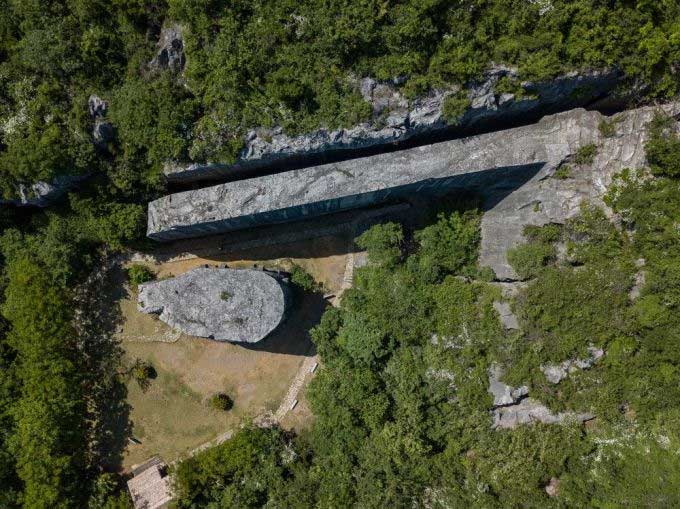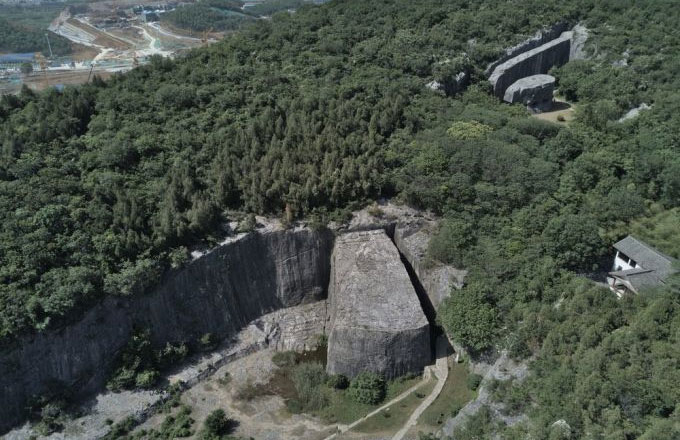The 31,000-ton stone stele of the Chinese emperor
The stone stele with 3 parts: base, body and top, totaling more than 70 m high and cast from mountain rock, is so massive that it cannot be moved and is being wasted.
The ancient Yangshan quarry is located in the hills near the ancient capital of Nanjing, southeastern China. Limestone from the Yangshan mine was mined during the Six Dynasties period (early 3rd to late 6th century) and used to build buildings, city walls, and statues in and around Nanjing. In particular, after Zhou Yuanzhang established the Ming Dynasty in 1368, Duong Son mine became the main source of stone for all major construction projects that changed the face of Nanjing.

The body and top of the stone stele in Duong Son quarry. (Photo: Megalithic China).
Today, Duong Son mine is no longer so glorious. However, people interested in Chinese history still visit this place to admire a giant unfinished stone stele.
Emperor Yongle (real name Zhu De) commissioned the stele with the intention of erecting this monolithic stone on the tomb of his father, Zhu Yuanzhang. Yongle was one of China's great emperors but was also very cruel, torturing and taking the lives of anyone who rebelled against his dynasty.
In 1405, Emperor Vinh Lac ordered a giant stele to be cut in Duong Son quarry. The stele must be cut into three separate parts: the rectangular base, the tall and flat body, and the decorated top. Vinh Lac wanted his father's memorial project to be the largest in China. The dimensions he asked the engineers to make were extremely impressive: the base was 16 m high and 30 m long, the body was 50 m high, and the top was 10 m high. If completed and reassembled, the stele will be more than 70 m high.
Thousands of workers spent years clearing the hillsides and carving stone from the mountains. According to the story, workers who did not produce enough rubble according to the daily norm would be executed on the spot. To commemorate those who died at the construction site, including those who died from overwork and illness, a nearby village was named Fentou, or "Go Mo".

The base of the stele (near the middle of the photo), the body and the top (upper right corner). (Photo: Megalithic China).
With enormous labor and expense, three parts of the stele were chiseled almost completely away from the mountain. Then the engineers realized the emperor's madness: There was no way to move the massive stele weighing a total of 31,000 tons from the quarry to the grave site.
As a result, the project was canceled and Emperor Vinh Lac had to make a much smaller stele. The new stele was installed at Minh Hieu mausoleum in 1413, consisting of a stone turtle supporting a carved stone slab, topped with hornless dragons. Although only 9 meters high, this is still an impressive memorial.
The stele at the Yangshan quarry was a wasted effort, but the Yongle emperor did some great things for China. He ordered the repair of the Grand Canal - the water canal connecting northern and southern China. He moved the capital from Nanjing to Beijing and built the Forbidden City, a massive structure that became the residence of Chinese kings for many centuries.
Emperor Yongle also built the Nanjing Porcelain Tower, one of the wonders of the world before it was destroyed in the 1856 uprising. He also promoted marine exploration, helping to expand the influence of China. China reaches all the way to Africa and the Middle East.
- Discover the oldest stone stele in Vietnam
- Stele filled with ancient characters challenges scientists
- 1001 Chinese Emperor's rules of lovemaking: Unexpected stories!
- The secret still covers the tomb of Qin Shihuang
- DNA technology helps reconstruct the face of Chinese emperors of the Northern Zhou period
- Ancient stone steles in the
- How did the Chinese emperor experience the night of the room?
- Little known pleasures and passions of Chinese emperors
- Great lavish marriage of the Chinese emperor
- The two sides of the eminent, wild, Chinese emperor
- The bizarre hobby of the youngest Chinese Emperor
- Why hasn't China dared to excavate the tomb of Qin Shui Huang?
 Discovered an ancient centipede fossil 99 million years old
Discovered an ancient centipede fossil 99 million years old Discovered bat-like dinosaurs in China
Discovered bat-like dinosaurs in China Discovered a 200-year-old bronze cannon of the coast
Discovered a 200-year-old bronze cannon of the coast Discover 305 million-year-old spider fossils
Discover 305 million-year-old spider fossils